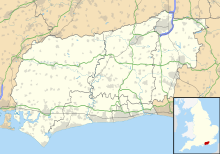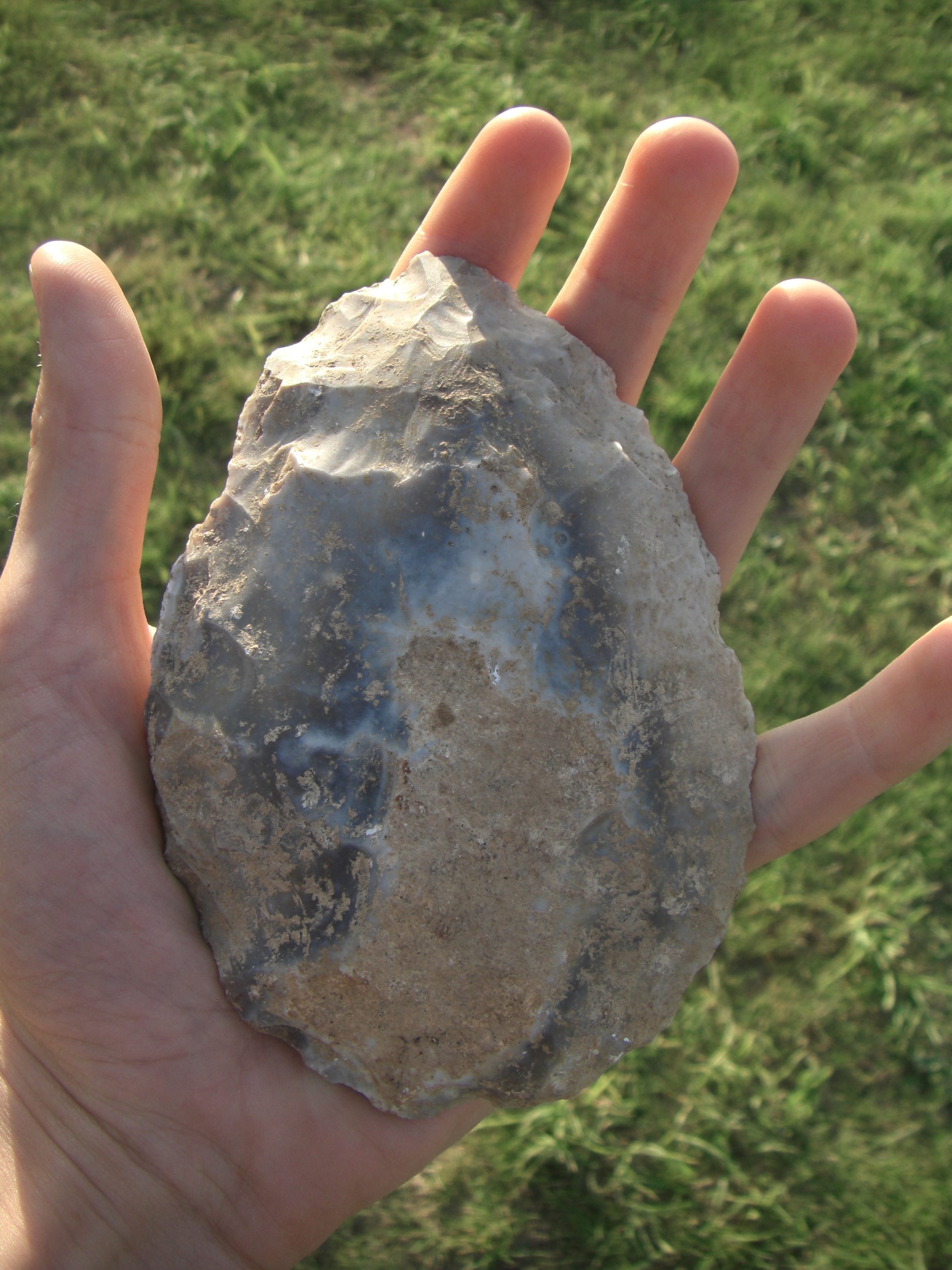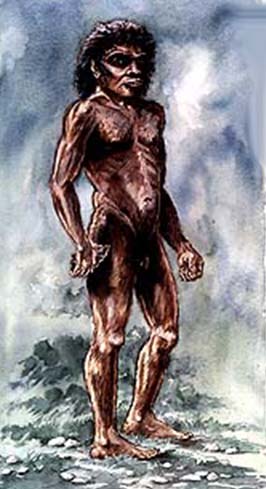Eartham Pit, Boxgrove
50.8575-0.71222222222222
Boxgrove Quarry, also called Amey 's Eartham Pit, is a altpaläolithischer find site on the outskirts of Boxgrove in West Sussex, southern England. The main reservoir layer comes from the late Cromer complex and has a geological age of at least 500,000 years.
The site in the gravel pit Boxgrove Quarry was excavated in the years 1983 to 1996 by a team from the Institute of Archaeology, University College London, led by Mark Roberts for the most part. The site is located on an eroded chalk cliff. Near the 75 km eastern city Seaford project over the geologically similar chalk deposits ( Seven Sisters Formation) to this day the sea.
Stratigraphy / geology
Since it is in the reference to an open gravel pit that was in places already driven a few meters in depth, could stratigraphic profiles of several meters, horizontally and vertically, are created that allow a good reconstruction of the regional landscape development.
The deposits of the lower layers directly the upcoming chalk rock auflagernd and penetrated at the base of larger chunks of chalk are called Slindon Sands. Your fine grain structure is due to the erosive action of water movements of the ocean surf, which once ranged zoom right up to the cliff. Tectonic uplift of the coastal region by 5-7 m the shoreline retreated to the south, and in advance of the cliff was formed a lagoon that dried up further in the subsequent period, a grassy landscape trained and went through renewed flooding in marshlands. The deposited in the lagoon silts are as Slindon Silts ( silt = silt ), and they contain organic components characteristic of both landscape phases after sedimentation. Slindon Slindon Sands and Silts together form the Slindon Formation, were deposited during an interglacial. At the sediments of the overlying layers ( Lower Eartham Gravel Member) can be read off the transition to a distinct glacial. Roberts and Parfitt call the Anglian glaciation (equivalent to the Elster glaciation in Central Europe) as the most likely climate phase for the designated as Upper Eartham Gravel Members layer packet. Lower and Upper Eartham Gravel Members form the Eartham formation. These layers are characterized by coarse gravel gravel, composed of the accelerated by the glacial conditions eroded Kalkkliff.
Paleontology
In the course of geological studies and paleontological observations were made, which are embedded in the rocks and sediments fossils and microfossils have been investigated and specified.
It could foraminifera and ostracods are observed, whose rising and falling again biodiversity, ie the number of coexisting species is climate dependent and correspond with the assumed interglacial. The fact that the sea once reached to approach the cliff, could be detected in the Slindon Sands, but also various mollusks testify by traces of the ichthyofauna.
Fauna
During the excavations of various animals could be recovered in the individual layers numerous bones. This allows the reconstruction of the fauna as a whole, but especially the reconstruction of faunal communities during the formation einzelnener layers. In addition, for many animal species are preferred climatic conditions known, which in turn allows conclusions on the prevailing temperatures, rainfall and the like at different times.
In addition to the avifaunischen remains of a duck ( several bones of a wing ) and the single bone fragment of a Riesenalks ( Pinguinus impensis ) mammals (Mammalia ) constitute the largest group among the faunal remains. The wolf (Canis lupus), of which a complete skull, numerous mandibles ( lower jaw) and other skeletal parts were found, is the most abundant large carnivore, followed by ( caves ) bear (Ursus deningeri ). The small carnivores of mink (Mustela lutreola ) is the most common representative. The badger ( Meles sp.) Could only be detected with a single copy. For the large cervids, red deer (Cervus elaphus ) was most frequently observed, followed by roe deer ( Capreolus capreolus ), while the Bison (Bison cf schoetensacki ) with a few residues represents the bovids. Among the odd-toed ungulates, especially two species of rhinoceros are emphasized ( Stephanorhinus hundsheimensis and Stephanorhinus megarhinus ). Furthermore, the mole ( Talpa minor) and the beaver (Castor fiber) in addition to others are also represented.
Dating methods used
For the age determination of the reference various dating methods have been applied.
Uranium -thorium dating: four bones from Boxgrove were analyzed using the uranium -thorium dating. From the results, however, could only be deduced that the bone must be older than 350,000 years.
Luminescence dating: were examined sediment samples / clay. The examined on thermoluminescence samples yielded a minimum age of 175300-319900 years with an extremely high margin of error of up to / -93 800 years. The same could be observed in the OSL dating ( Optically Stimulated Luminescence ). So yielded a sample an age of 356,000 / -178,000 years, a second sample of an age of 630,000 / -125,000 years, and a third sample 560,000 / -330,000 years.
ESR Electron Spin Resonance: Two teeth of rhinoceros and stag were examined with the electron spin resonance method. The majority of the results is between 190.000-244.00 years with error ranges from 151,000 to -89 000 years. The most likely time frame of the study data is specified with 205000-281000 years. However, the results include a possible average age of 303000-339000 years is not enough.
Amino acid dating: The amino acid dating has been applied to mollusks and foraminifera. The majority of the results points to the oxygen isotope stage 11 ( 362000-423000 years), single to Level 13 ( 478000-524000 years).
Paleomagnetism: The paleomagnetic investigations of the sediments could only lead to the conclusion that the polarization speak for sedimentation during the Brunhes period, which is between 0-780000 years ago today.
Investigation of calcareous nannoplankton: The calcareous nannoplankton contained in sediment samples was deposited between the oxygen isotope stages 12 and 8, mainly during stage 11
Biostratigraphy: The biostratigraphy indicates the oxygen isotope stage 13
Summary: The results of the uranium -thorium dating and paleomagnetism of the result in a frame dating between 350000-780000 years before present. The other investigation methods provided different results, but essentially they fluctuate between the oxygen isotope stages 13 and 11 Roberts and Parfitt tend to the classification in the OIS 13 before the Anglian glaciation.
Archaeological finds
Numerous stone tools, primarily bifaces of the Acheulean, but also a few scratches and scrapers, and especially the reduction of processing residues belong to the anthropogenic discovery. The flint used is created in large quantity in the Kalkkliff locally and contain. Some bones were cut and hack marks from the cutting operations, and to suggest some tools macroscopic traces on a use for breaking down the prey, are observed.
A semi- circular hole in the shoulder blade (scapula ) of a horse could be the entrance channel of a lance or a spear. Whether the findings but actually prove the hunting of these animals is doubtful, because unique hunting weapons were not found. The various early Homo species have been shown to predominantly feed on carrion, has exactly when the transition to the active hunting place is still not clarified beyond doubt. The oldest evidence of prehistoric hunting weapons are the Schöninger spears, whose age is estimated at about 300,000 years BP.
Skeletal remains
In December 1993, fragments of a tibia (shin bone ) were found, the oldest human remains in the British Isles. Anthropological studies showed that they belonged to a man of about 1.80 meters in size and 80 kg weight, who died around the age of 35-40 years. As the allocation is made of fossils to a kind primarily on skull features, the assignment is only through a tibia quite difficult. Roberts and Parfitt have therefore measured and compared various tibia fragments from other sites. Since the discovery in Boxgrove but is the only one not originating from the skull bones found in an individual of Hominini in northern Europe, they had to resort to more geographically remote copies. The results allow only the statement that Homo erectus, Homo heidelbergensis, the Neanderthals and anatomically modern humans might come into question. Due to the dating of the site, via the tool shapes ( hand ax ), biostratigraphy and environmentally specific biodiversity and increased extent of the geology, in a time range of about 500,000 BP, the allocation of the tibia is excluded for anatomically modern humans; question is most likely Homo heidelbergensis. Both ends of the bones show signs of gnawing, which means that the Boxgrove human prey, or whose bodies were carrion for other animals.
1996 two incisors of another individual were found. But you could see it Paradontalerkrankungen, besides also here cut marks. Interprets but these were not as evidence of cannibalism, but rather for the use of stone tools in the vicinity of the mouth and related accidents.
2003 was reported English Heritage, sought to acquire the find site to allow further excavations and to protect the Fund complex.









